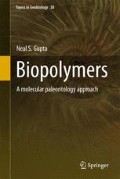Abstract
Analysis of the solvent insoluble residue of a cyanobacterium (Oscillatoria sp.) subjected to simulated diagenesis under hydrothermal conditions (350 and 260 °C and hydrostatic pressure of 700 atmospheres) affords a macromolecule with significant aliphatic content that is similar to that found in hydrogen rich kerogen. The aliphatic component is primarily derived from incorporation of the original fatty acids into a solvent insoluble polymer, as demonstrated by performing similar experiments with model lipid compounds. Bacterial biomass can, therefore, contribute significantly to the insoluble organic inventory in ancient sediments.
Access this chapter
Tax calculation will be finalised at checkout
Purchases are for personal use only
References
Allard B, Templier J, Largeau C (1997) Artifactual origin of mycobacterial bacteran. Formation of melanoid-like artifactual macromolecular material during the usual isolation process. Org Geochem 26:691–703
Cody GD, Boctor NZ, Hazen RM, Brandes JA, Morowitz HJ, Yoder HS (2001) Geochemical roots of autotrophic carbon fixation: hydrothermal experiments in the system citric acid, H2O-(FeS)-(NiS). Geochim Cosmochim Acta 65:3557–3576
Damsté JSS, Schouten S (1997) Is there evidence for a substantial contribution of prokaryotic biomass to organic carbon in Phanerozoic carbonaceous sediments? Org Geochem 26:517–530
de Leeuw JW (2007) On the origin of sedimentary aliphatic macromolecules: a comment on recent publications by Gupta et al. Org Geochem 38:1585–1587
de Leeuw JW, Versteegh GJM, van Bergen PF (2006) Biomacromolecules of algae and plants and their fossil analogues. Plant Ecol 182:209–233
Gupta NS, Michels R, Briggs DEG, Evershed RP, Pancost RD (2006) The organic preservation of fossil arthropods: an experimental study. Proc R Soc Lond B 273:2777–2783
Gupta NS, Michels R, Briggs DEG, Collinson ME, Evershed RP, Pancost RD (2007) Experimental evidence for the formation of geomacromolecules from plant leaf lipids. Org Geochem 38:28–36
Gupta NS, Yang H, Leng Q, Briggs DEG, Cody GD, Summons RE (2009) Diagenesis of plant biopolymers: decay and macromolecular preservation of Metasequoia. Org Geochem 40:802–809
Hartgers WA, Sinninghe Damste JS, Requejo AG, Allan J, Hayes JM, de Leeuw JW (1994) Evidence for a small bacterial contribution to sedimentary organic carbon. Nature 369:224–227
Harvey HR, Macko SA (1997) Catalysts or contributors? Tracking bacterial mediation of early diagenesis in the marine water column. Org Geochem 26:531–544
Head I, Farrimond P, Larter S (1995) Organic carbon in sediments. Nature 373:293
Kodner RB, Summons RE, Knoll AH (2009) Phylogenetic investigation of the aliphatic, non-hydrolyzable biopolymer algaenan, with a focus on green algae. Org Geochem 40:854–862
Larter SR, Horsfield B (1993) Determination of structural components of kerogens by the use of analytical pyrolysis methods. Top Geobiol 11:271–287
Michels R, Landais P, Torkelson BE, Philp RP (1995) Effects of confinement and water pressure on oil generation during confined pyrolysis, hydrous pyrolysis and high pressure hydrous pyrolysis. Geochim Cosmochim Acta 59:1589–1604
Moers MEC, Jones DM, Eakin PA, Fallick AE, Griffiths H, Larter SR (1993) Carbohydrate diagenesis in hypersaline environments: application of GC-IRMS to the stable isotope analysis of derivatized saccharides from surficial and buried sediments. Org Geochem 20:927–933
Oren A, Fattom A, Padan E, Tietz A (1985) Unsaturated fatty acid composition and biosynthesis in Oscillatoria limnetica and other cyanobateria. Arch Microbiol 141:138–142
Ourisson G, Albrecht P (1992) Hopanoids. 1. Geohopanoids: the most abundant natural products on earth? Acc Chem Res 25:398–402
Ourisson G, Albrecht P, Rohmer M (1984) The microbial origin of fossil fuels. Sci Am 251:44–51
Parkes RJ, Cragg BA, Getliff JM, Harvey SM, Fry JC, Lewis CA, Rowland SJ (1993) A quantitative study of microbial decomposition of biopolymers in recent sediments from the Peru Margin. Mar Geol 113:55–66
Parkes RJ, Cragg BA, Bale SJ, Getliff JM, Goodman K, Rochelle PA, Fry JC, Weightman AJ, Harvey SM (1994) Deep bacterial biosphere in Pacific Ocean sediments. Nature 371:410–412
Stankiewicz BA, Briggs DEG, Michels R, Collinson ME, Evershed RP (2000) Alternative origin of aliphatic polymer in kerogen. Geology 28:559–562
Summons RE, Powell TG (1986) Chlorobiaceae in Palaeozoic seas revealed by biological markers, isotopes and geology. Nature 319:763–765
Torréton J-P, Guiral D, Arfi R (1989) Bacterioplankton biomass and production during destratification in a monomictic eutrophic bay of a tropical lagoon. Mar Ecol Prog Ser 57(53):67
Versteegh GJM, Blokker P, Wood GD, Collinson ME, Damsté JS, de Leeuw JW (2004) An example of oxidative polymerization of unsaturated fatty acids as a preservation pathway for dinoflagellate organic matter. Org Geochem 35:1129–1139
Westall F, Folk RL (2003) Exogenous carbonaceous microstructures in early Archean cherts and BIFs from the greenstone belt: implications for the search for life in ancient rocks. Precambrian Res 126:313–330
Author information
Authors and Affiliations
Rights and permissions
Copyright information
© 2014 Springer Science+Business Media Dordrecht
About this chapter
Cite this chapter
Gupta, N.S. (2014). Molecular Transformation of Bacteria at High P-T Conditions. In: Biopolymers. Topics in Geobiology, vol 38. Springer, Dordrecht. https://doi.org/10.1007/978-94-007-7936-5_10
Download citation
DOI: https://doi.org/10.1007/978-94-007-7936-5_10
Published:
Publisher Name: Springer, Dordrecht
Print ISBN: 978-94-007-7935-8
Online ISBN: 978-94-007-7936-5
eBook Packages: Earth and Environmental ScienceEarth and Environmental Science (R0)

